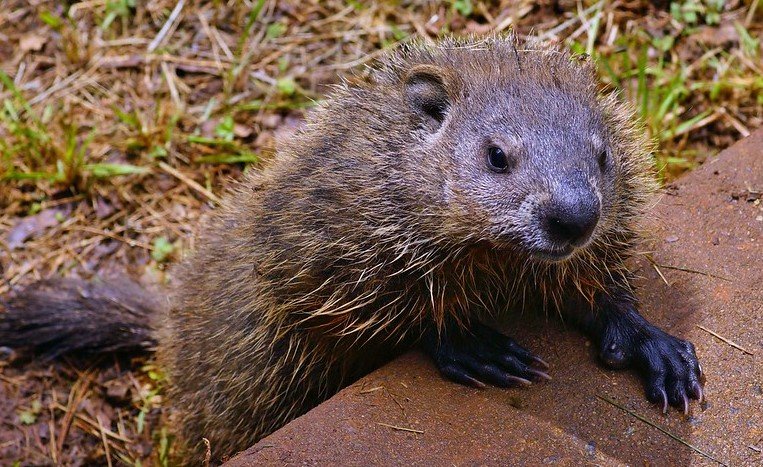Our Backyard Groundhogs: Common, But for How Long? by Alan Borer
Sometimes a writer has an assignment but has nothing to go on. Groundhogs in Westerville? Just not too much out there. Checked the standard histories; checked the Public Opinion; checked Google and some other websites; nothing about groundhogs in Westerville, or even Blendon Township. The most common result was advertising for varmint control websites. Pest control, rodent extermination, and any number of violent animal eradication websites in Delaware and Franklin Counties. Nothing, about the folk belief of groundhogs foretelling the length of winter, a Pennsylvania German transplant. In the old country, it was not even a groundhog, but a badger.
Then it occurred to me. I live In Westerville. I see groundhogs all the time, except for the winter. Our backyard abuts a tiny creek that runs, eventually, into Alum Creek. My wife and I are serious gardeners, and part of that happy chore is to keep an eye on groundhog predation. Groundhogs can ruin a garden pretty quickly if given free reign. All these things being true, I realized that a story of groundhogs in Westerville could be assembled by recalling times we have looked out our window or giving chase to misbehaving groundhogs.
Groundhogs belong to the marmot family of rodents. They grow to a pretty hefty size; in summer when they are feeding more or less all day, they can reach over eight to twelve pounds. Like all rodents, the groundhog has a somewhat intimidating jaw. Powerfully built, a groundhog jaw has tendons that wrap around the skull from top to bottom, enabling the living animal to deliver a whole-head bite. I have a groundhog skull on my desk at home, and while it has never snapped at me, I think it could take a finger off if it was still alive.
Another oddity about the groundhog is their claws. Unlike domesticated animals like cats and dogs, groundhogs have long, mainly hairless claws on all four legs. I am sure that this was an evolutionary plus, giving the animal the power to dig burrows. Farmers and yes, gardeners love to hate groundhog holes, and many stories are told of ways to settle their hash. Groundhog claws are a bit creepy, connected as they are to a hefty, fast moving rodent. Groundhogs are rarely vicious, but I would not care to get the claws too close to my hide or my eyes.
The groundhogs we see in spring and summer are foraging for their food: shoots, twigs, and plants, plus grubs, beetles, insects, and the occasional snail. Their favorite meal seems to be clover. In hopes of keeping them away from our garden, we leave unmown grass patches near the creek to attract the groundhogs to the lawn we want them to eat, and keep them away from the garden we want to eat. In theory we should both be happy, but the poor whistlepig follows his nose, not his diminutive brain.
When frightened or startled, the groundhog runs for it. “Our” groundhogs make a bee line for the scrubby brush that borders the creek. Hardly a wilderness, the creek bed is in shadow once the leaves come out in the spring, and the groundhog hides in these shadows, until hunger drives them back into the light. A fat groundhog can galumph at a relatively high rate of speed. Waves of fat make the groundhog undulate while they run! We have seen one or two young groundhogs join in these races.
While we still see groundhogs, there seems to be a downward trend in their population. That may be a natural cycle, but I have a hunch that it may be a long term downward trend. Anyone who can drive and cares to watch can see that the countryside is moving further and further away. When we moved to Westerville in 2003, and saw our first groundhog, the Meijer store on North State Street was only a few months old. Think how heavily developed that whole Polaris intersection is now, and how many fewer groundhogs that area can support. As climate change progresses, it will reduce the groundhog population in another way.
Do I think I’ve seen my last Westerville groundhog? No. Is the species doomed? I don’t know, but I hope more Westerville folks will leave clover patches to give them a fighting chance.
- Alan Borer
Photo credit: Stephen Little on Flickr

